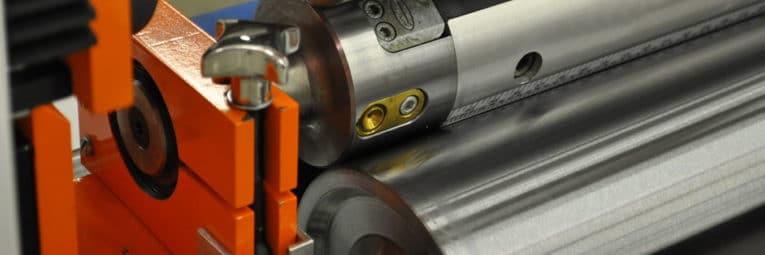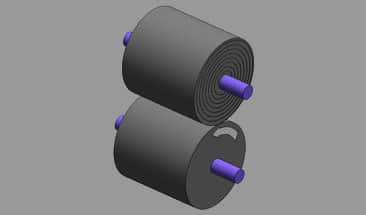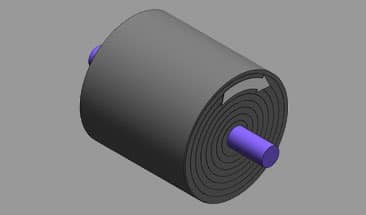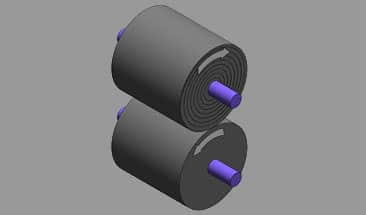
- Home
- All Posts
- Rewinding Technology
- Winding Types of Slitting and Rewinding Machines
Blog

Winding Types of Slitting and Rewinding Machines
Winding process is essential to consistently manufacturing high-quality rolls in slitting and rewinding machine. The process of winding material into a roll produces internal forces which may potentially damage your mat erial by using the improper type of winding method. There are many factors need to be considered such as required core sizes, type of material and the weight of finished roll while selecting of winding type, and understanding “TNT” winding principles(tension, nip, and torque) is important in deciding the right winding method. Below is an overview of common winding types and their respective applications.
Surface winding
 Also known as contact rewinding or friction winding, the web is driven by the one or more winding drums(generally driven by motor) which are in contact with the outer layer of the material being rewound due to the nip principle. Nip loading can offer proper traction between the driven drums and winding roll, and further to control the density of finished package. The speed differences between the driven rollers imparts tension in the web material. The torque principle also applies to surface winding, when two or more driven rollers are in contact with the rewinding roll, tightening or loosening of the outer layer of material being wound into the roll can be controlled by changing the torque between these rollers. Because the driving power for winding package does not rely on its increasing diameter, the surface rewinding system are commonly use less power than center winding system, it’s a economical slitting and rewinding system and easier to operate and maintain.
Also known as contact rewinding or friction winding, the web is driven by the one or more winding drums(generally driven by motor) which are in contact with the outer layer of the material being rewound due to the nip principle. Nip loading can offer proper traction between the driven drums and winding roll, and further to control the density of finished package. The speed differences between the driven rollers imparts tension in the web material. The torque principle also applies to surface winding, when two or more driven rollers are in contact with the rewinding roll, tightening or loosening of the outer layer of material being wound into the roll can be controlled by changing the torque between these rollers. Because the driving power for winding package does not rely on its increasing diameter, the surface rewinding system are commonly use less power than center winding system, it’s a economical slitting and rewinding system and easier to operate and maintain.
Surface winding is frequently used to produce materials with large-diameter rolls, and suitable for materials which are not sensitive to being compressed or nipped, such as textiles, nonwovens, paper, etc. Heavy finished packages can be produced on small cores as the roll weight is completely supported along its length while rewinding. Besides, if loosely packed finished rolls are desired, surface winding method is not recommended.
Center winding
 The wind shaft is common driven by a motor and the winding force is transmitted to the web material through the core. The roll formation can be adjusted by changing both tension and nip force on center winding system. Center winding provides an effective solution to manufacture high-quality rolls of sensitive materials. These slitting or rewinding machines can wind the rolls with low wound-in-tension and can handle materials more gently.
The wind shaft is common driven by a motor and the winding force is transmitted to the web material through the core. The roll formation can be adjusted by changing both tension and nip force on center winding system. Center winding provides an effective solution to manufacture high-quality rolls of sensitive materials. These slitting or rewinding machines can wind the rolls with low wound-in-tension and can handle materials more gently.
Center winding is appropriate for Nip-sensitive plastic film or composites, heavy sheet, delicate nonwovens and paper, and materials must be wound at lower tensions or sensitive to compression during winding process. However, there still have many limitions such as the weight of finished roll, the strength of the winding shaft or core, and the maximum diameter is limited by the allowable torque from the drive motor. A larger diameter core to accommodate a larger diameter winding shaft is necessary.
Center-surface winding
 Both rewind shaft and winding drum are driven to apply the force on winding process. The lay-on roll loading applied to the winding roll controls the nip and the torque from the center drive is programmed to produce the desired in-wound tension for the roll hardness profile desired. The web tension is controlled by the surface drive and used for slitting and web spreading. Center-surface rewinding provides the optimum control of the density of the rewinding package.
Both rewind shaft and winding drum are driven to apply the force on winding process. The lay-on roll loading applied to the winding roll controls the nip and the torque from the center drive is programmed to produce the desired in-wound tension for the roll hardness profile desired. The web tension is controlled by the surface drive and used for slitting and web spreading. Center-surface rewinding provides the optimum control of the density of the rewinding package.
The advantage of center-surface winding is that the winding tension can be controlled independently of the web tension, it can wind with best control of inwound tension and improve the ability to produce shippable quality slit rolls off the production winder, suitable to wind high-slip and extensible webs to larger diameters.
The above is a simple explanation of which slitting and rewinding machine would be best suited for your web production line. Each application is unique for you and other factors may affect the decision on what machine is chosen. So it’s better to consult with LEAP technicans to help you choose the best type of winding system and options for your unique application.
About Lvjie
Serch
Recent Posts
-
Overview of UHMWPE Separato... September 20, 2024
-
Overview of PVC Slitter Rew... July 2, 2024
-
Overview of Pre-coated Film... April 25, 2024
-
Overview of stretch film sl... March 11, 2024
-
Application of BOPP Tape Sl... November 29, 2023
Categories
- All Posts (28)
- Others (1)
- Unwinding Technology (3)
- Rewinding Technology (7)
- Slitting System (18)
- Control System (4)
Contact Info

Xiongzhou Street, Liuhe District, Nanjing City, 211511, China
Phone: 86 025 86555699Email: info@film-slitter.com
Recent Posts
-
Overview of UHMWPE Separato... September 20, 2024
-
Overview of PVC Slitter Rew... July 2, 2024
-
Overview of Pre-coated Film... April 25, 2024
-
Overview of stretch film sl... March 11, 2024
-
Application of BOPP Tape Sl... November 29, 2023
